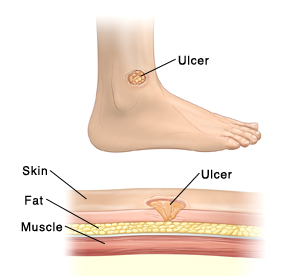Simple Pressure Injury
A pressure injury is a sore on the skin. They're caused by pressure on a particular spot on the skin. Prolonged pressure doesn't allow good blood flow to the area. They're most often seen in people who use a wheelchair or who can't leave their bed. Pressure injuries often occur on the back, buttocks, or backs or sides of the legs, arms, or feet (especially the heels). The injuries are generally round areas of red, swollen, thickened skin around a crater-like depression. The injury is often very slow to heal. If it isn't treated, it may become infected. If the infection spreads, it can cause serious health issues.

Symptoms of a pressure injury include:
-
A reddish area on the skin.
-
Skin color and texture changes.
-
Swelling.
-
A wound that isn't healing.
-
A crater in the skin.
-
Pain.
-
Drainage or pus.
Risk factors
There are many risk factors for pressure injuries. They include:
-
Decreased blood flow to a part of the skin.
-
Trauma.
-
Lack of or little movement of a part of the body for long periods of time.
-
Infection.
-
Poor hygiene.
-
Varicose veins.
-
Vitamin deficiency and poor nutrition.
-
Diabetes.
-
Numbness and reduced ability to feel injuries.
-
Age-related thinning of the skin.
Home care
You may get antibiotics to prevent infection. If this is the case, take them as directed. Do not stop taking them just because you feel better. You need to take the full course of antibiotics. You may also be given medicines to help relieve pain. Follow the doctor’s instructions when using them.
You'll also be taught how to keep pressure off the affected area. You can also use different positions and supports to prevent pressure injuries to other parts of the body. Assistive mobility devices, such as wheelchairs and canes, or skin protectors may be checked. This is to make sure they're a correct fit for your body.
General care
-
Care for the skin ulcer as instructed. Always wash your hands with soap and clean, running water before and after caring for your wound.
-
Cover the ulcer with a clean, dry bandage. Remove and change the bandage as advised. If the bandage becomes wet or dirty, change it as soon as possible.
-
Follow the doctor’s instructions about washing. You can shower, but don't soak the healing ulcer until the doctor says it’s OK.
-
Don't scratch, rub, or pick at the healing skin.
-
Check the area every day for signs of infection, such as increasing pain, redness, warmth, red streaking, swelling, or pus draining from the pressure injury.
-
When resting, raise the area where the pressure injury is above the level of the heart.
-
Don't smoke or drink alcohol. These can delay wound healing.
-
If you can, try to walk regularly. This can help with circulation.
-
Don't stand or sit in 1 position for long periods.
-
Ask about home physical therapy services if you're weak and need to gain strength so you can move.
These tips can help prevent future pressure injuries:
-
Know your risks for pressure injuries.
-
Keep the skin clean and dry.
-
Don't stay in 1 spot. Reposition yourself frequently.
-
Use protective devices, such as pillows, foam wedges, and heel protectors for the knees, ankles, and heels.
-
Exercise as you're able.
-
If mobility or protective devices are used, check them on a regular schedule to make sure they fit correctly.
-
Eat a healthy, well-balanced diet.
Follow-up care
Follow up with your doctor, or as advised.
When to contact your doctor
Contact your doctor or get medical care right away if:
-
You have a fever of 100.4°F (38°C) or higher, or as advised by your doctor.
-
You have signs of infection. These include increasing pain, warmth, redness, or pus draining from the pressure injury.
-
You bleed from the pressure injury.
-
You have pain in or around the injury that doesn't get better even with medicines.
-
You have increased swelling.
-
Your skin changes color.
-
You have a new pressure injury.
Online Medical Reviewer:
Daphne Pierce-Smith RN MSN
Online Medical Reviewer:
Rita Sather RN
Online Medical Reviewer:
Vinita Wadhawan Researcher
Date Last Reviewed:
5/1/2025
© 2000-2025 The StayWell Company, LLC. All rights reserved. This information is not intended as a substitute for professional medical care. Always follow your healthcare professional's instructions.